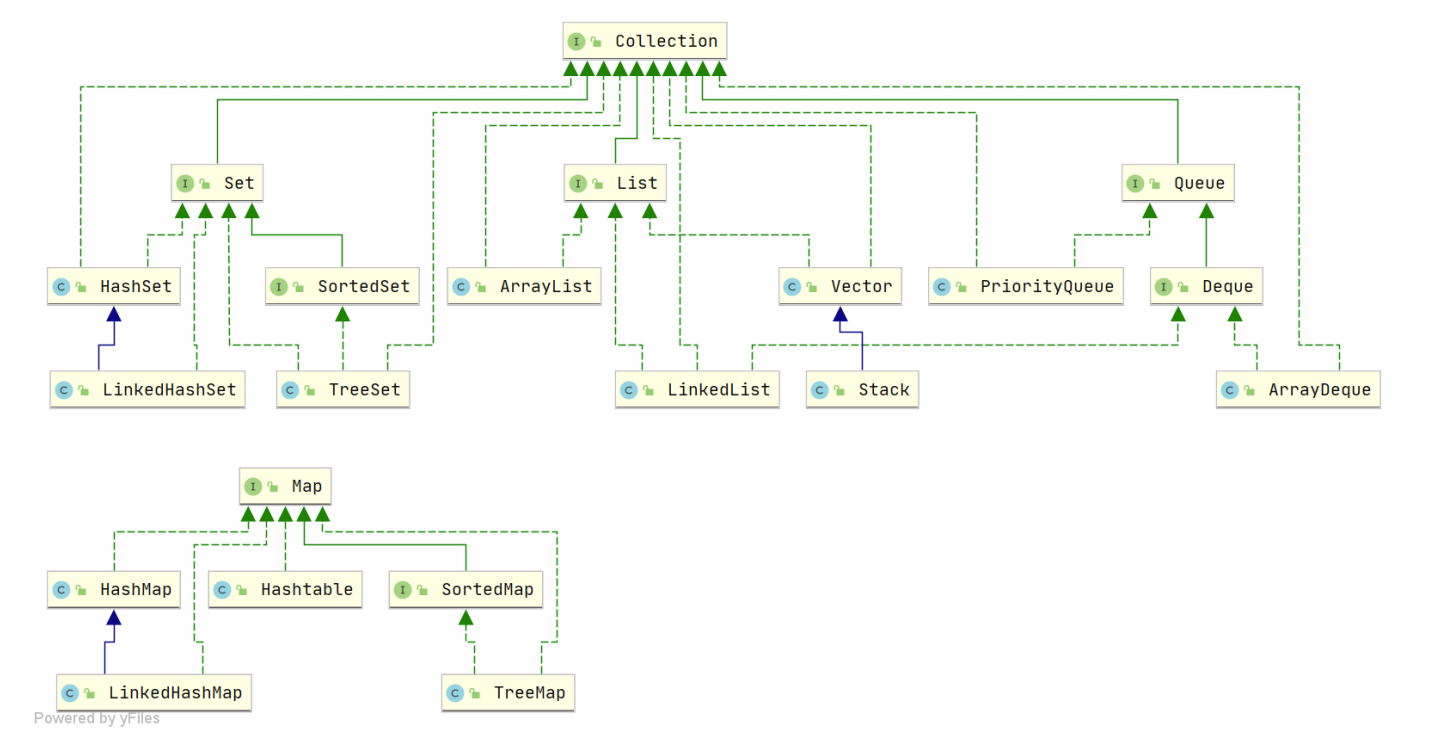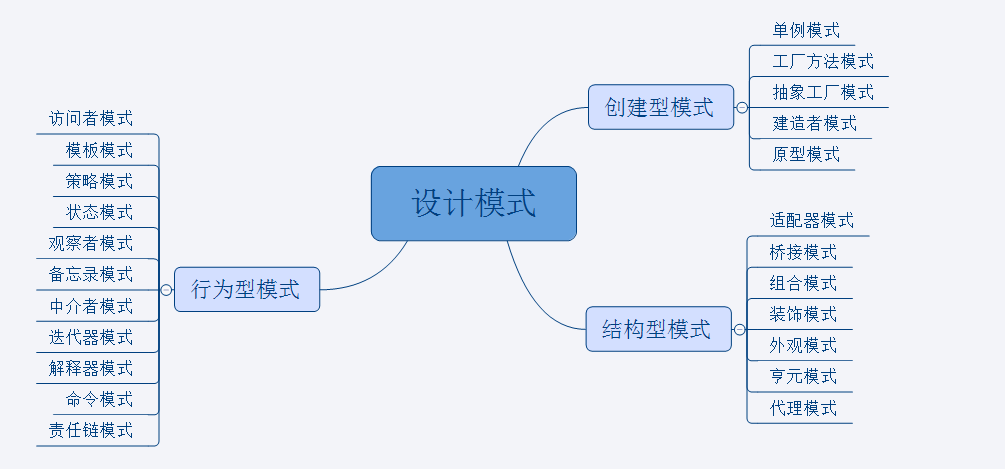file:///D:/Download/%E4%B8%8B%E8%BD%BD/%E9%9D%A2%E8%AF%95%E7%AA%81%E5%87%BB-Java%E5%9F%BA%E7%A1%80%EF%BC%88%E6%9A%97%E8%89%B2%EF%BC%89.pdf
https://javaguide.cn/java/io/io-model.html#nio-non-blocking-new-i-o
集合部分:
file:///D:/Download/%E6%96%87%E6%A1%A3/WeChat%20Files/wxid_y5fy507qqs9q22/FileStorage/File/2025-07/%E9%9D%A2%E8%AF%95%E7%AA%81%E5%87%BB-Java%E9%9B%86%E5%90%88%EF%BC%88%E4%BA%AE%E8%89%B2%EF%BC%89.pdf
一、集合
Java 集合,也叫作容器,主要是由两⼤接⼝派⽣⽽来:⼀个是 Collection 接⼝,主要⽤于存放单⼀ 元素;另⼀个是 Map 接口,主要⽤于存放键值对。对于 Collection 接⼝,下⾯⼜有三个主要的子接⼝: List 、 Set 、 Queue 。 Java 集合框架如下图所示:

List
ArrayList 和 Array(数组)的区别?
ArrayList 与 LinkedList 区别?
说⼀说 ArrayList 的扩容机制吧
集合中的 fail-fast 和 fail-safe 是什么
Set
Comparable 和 Comparator 的区别
Comparable来自于java.lang包,排序方法是compareTo(Object b)
Comparator来自于java.utils包,排序方法是comparator(Object a, Object b)
⽐较 HashSet、LinkedHashSet 和 TreeSet 三者的异同
Queue
Map
二、多线程
三、输入输出流
四、高并发
五、设计模式
设计模式(Design pattern)是一套被反复使用、多数人知晓的、经过分类编目的、代码设计经验的总结。使用设计模式是为了可重用代码、让代码更容易被他人理解、保证代码可靠性。设计模式的三个分类:
创建型模式:对象实例化的模式,创建型模式用于解耦对象的实例化过程。
结构型模式:把类或对象结合在一起形成一个更大的结构。
行为型模式:类和对象如何交互,及划分责任和算法。
参考视频:https://www.bilibili.com/video/BV1vNN4zaEo7?spm_id_from=333.788.videopod.episodes&vd_source=5c14f766fdfaa0f3c9f5b3c4857d0bd2&p=8

| 模式 |
核心用途 |
典型场景 |
| 单例模式 |
全局唯一实例 |
配置管理、连接池 |
| 工厂模式 |
解耦对象创建 |
支付系统、日志记录器 |
|
|
|
| 观察者模式 |
状态变更通知 |
事件系统、消息订阅 |
| 策略模式 |
灵活切换算法 |
排序、支付策略 |
|
|
|
| 适配器模式 |
兼容旧接口 |
系统集成、第三方库适配 |
| 装饰器模式 |
动态扩展功能 |
I/O流、UI组件增强 |
1. 单例模式(Singleton)
目的:确保一个类只有一个实例。
示例:数据库连接池
1
2
3
4
5
6
7
8
9
10
11
12
13
14
| public class DatabaseConnection {
private static DatabaseConnection instance;
private DatabaseConnection() {}
public static synchronized DatabaseConnection getInstance() {
if (instance == null) {
instance = new DatabaseConnection();
}
return instance;
}
}
DatabaseConnection db = DatabaseConnection.getInstance();
|
2. 工厂模式(Factory)
目的:将对象创建逻辑封装起来。实际是利用了面向对象的多态,创建同一父类的不同子类对象。
示例:支付方式工厂
1
2
3
4
5
6
7
8
9
10
11
12
13
14
15
16
17
18
19
20
21
22
23
24
25
26
27
28
29
30
31
| public interface Payment {
void pay(int amount);
}
class CreditCard implements Payment {
@Override
public void pay(int amount) {
System.out.println("信用卡支付:" + amount);
}
}
class PayPal implements Payment {
@Override
public void pay(int amount) {
System.out.println("PayPal支付:" + amount);
}
}
public class PaymentFactory {
public Payment createPayment(String type) {
return switch (type.toLowerCase()) {
case "creditcard" -> new CreditCard();
case "paypal" -> new PayPal();
default -> throw new IllegalArgumentException("未知支付类型");
};
}
}
PaymentFactory factory = new PaymentFactory();
Payment payment = factory.createPayment("PayPal");
payment.pay(100);
|
3. 观察者模式(Observer)
目的:对象状态变化时自动通知依赖对象。
示例:新闻订阅系统
1
2
3
4
5
6
7
8
9
10
11
12
13
14
15
16
17
18
19
20
21
22
23
24
25
26
27
28
29
30
31
32
33
34
35
36
37
38
| import java.util.*;
abstract Agency {
private List<Subscriber> subscribers = new ArrayList<>();
public void subscribe(Subscriber s) {
subscribers.add(s);
}
public void publishNews(String news);
}
class NewsAgency extends Agency{
public void publishNews(String news) {
for (Subscriber s : subscribers) {
s.update(news);
}
}
}
interface Subscriber {
void update(String news);
}
class User implements Subscriber {
private String name;
public User(String name) { this.name = name; }
@Override
public void update(String news) {
System.out.println(name + " 收到新闻: " + news);
}
}
// 使用
Agency agency = new NewsAgency();
agency.subscribe(new User("张三"));
agency.subscribe(new User("李四"));
agency.publishNews("Java 21 发布!");
|
4. 装饰器模式(Decorator)
目的:动态扩展对象功能。
示例:咖啡加料系统
1
2
3
4
5
6
7
8
9
10
11
12
13
14
15
16
17
18
19
20
21
22
23
24
25
26
27
28
| interface Coffee {
double getCost();
String getDescription();
}
class SimpleCoffee implements Coffee {
@Override public double getCost() { return 2.0; }
@Override public String getDescription() { return "基础咖啡"; }
}
abstract class CoffeeDecorator implements Coffee {
protected Coffee decoratedCoffee;
public CoffeeDecorator(Coffee coffee) {
this.decoratedCoffee = coffee;
}
}
class MilkDecorator extends CoffeeDecorator {
public MilkDecorator(Coffee coffee) { super(coffee); }
@Override public double getCost() { return decoratedCoffee.getCost() + 0.5; }
@Override public String getDescription() {
return decoratedCoffee.getDescription() + ", 加牛奶";
}
}
// 使用
Coffee coffee = new SimpleCoffee();
coffee = new MilkDecorator(coffee); // 动态添加功能
System.out.println(coffee.getDescription() + " 价格: $" + coffee.getCost());
|
5. 策略模式(Strategy)
目的:封装可互换的算法。可以看成是包装后的工厂模式,将对象的创建放在上下文中,隐藏了工厂模式中通过Factory创建对象的申明,使用成本更小。
示例:排序算法切换
1
2
3
4
5
6
7
8
9
10
11
12
13
14
15
16
17
18
19
20
21
22
23
24
25
26
27
28
29
30
31
32
33
34
| interface SortStrategy {
void sort(int[] array);
}
class BubbleSort implements SortStrategy {
@Override
public void sort(int[] array) {
System.out.println("使用冒泡排序");
}
}
class QuickSort implements SortStrategy {
@Override
public void sort(int[] array) {
System.out.println("使用快速排序");
}
}
class Sorter {
private SortStrategy strategy;
public void setStrategy(SortStrategy strategy) {
this.strategy = strategy;
}
public void executeSort(int[] array) {
strategy.sort(array);
}
}
int[] data = {5, 2, 9, 1};
Sorter sorter = new Sorter();
sorter.setStrategy(new QuickSort());
sorter.executeSort(data);
|
6. 适配器模式(Adapter)
目的:使不兼容接口协同工作。
示例:旧式播放器适配新接口
1
2
3
4
5
6
7
8
9
10
11
12
13
14
15
16
17
18
19
20
21
22
23
24
25
| interface MediaPlayer {
void play(String fileType, String fileName);
}
class LegacyPlayer {
public void playLegacy(String fileName) {
System.out.println("播放旧格式文件: " + fileName);
}
}
class PlayerAdapter implements MediaPlayer {
private LegacyPlayer legacyPlayer = new LegacyPlayer();
@Override
public void play(String fileType, String fileName) {
if (fileType.equals("legacy")) {
legacyPlayer.playLegacy(fileName); // 适配旧接口
} else {
System.out.println("不支持格式: " + fileType);
}
}
}
// 使用
MediaPlayer player = new PlayerAdapter();
player.play("legacy", "old_song.dat");
|

